The Data Dictionary is the first step in setting up a client’s Kurtosys Instance.
It’s where you build the framework or home for the data you will be loading into Kurtosys. Without the Data Dictionary Properties, your data cannot be accepted as the system will not know where to put it. Each of the data values loaded onto Kurtosys will need to be assigned to a Property.
How to set up Fund Properties in the Data Dictionary
Click the Settings cog on the main navigation bar. Click Data Dictionary.

Click + to the right of the Data Dictionary property tabs. This will open a list of property types.
Click Add Property to add a new property.
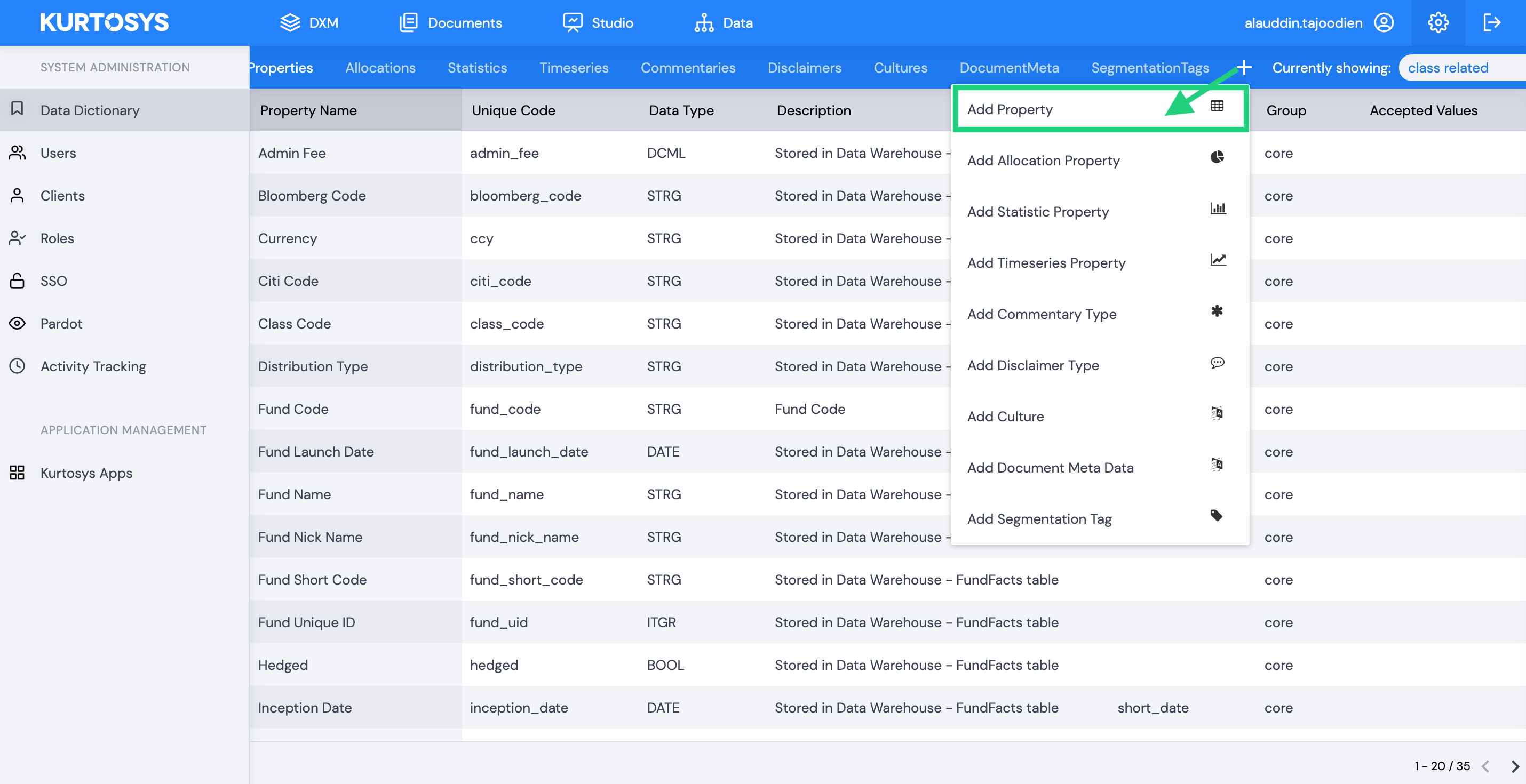
This will open a fillable form.

Note: The values of the first property added for an entity (Fund, Class, Benchmark, Account) will become the unique identifier for the entity. E.g. If you add the property ISIN to Class, all ISIN values will become the identifier for the share classes.
- code – this is the system name given to the property so that it is usable as a label in the code. Code should always be written in lower, snake case e.g. property_code_name or property-code-name-example.
- entityType – Kurtosys supports 4 different entity or asset types: FUND (Fund assets), CLSS (Share classes), BMRK (Benchmarks) and ACCT (Accounts). Choose the entity type to which you want to add the property.
- dataType – what data format can the system expect and therefore how it should be stored and displayed. Data types include STRG (string), DCML (decimal), ITGR (integer), DATE (date format), DTIM (date and time format), BOOL (Boolean – True or False).
- label – the name given to the property and displayed on the interface.
- description – any additional information about the property and its purpose.
- validationRule – should always be set to NONE.
- group – should be set to core.
- subgroup – is not a necessary field.
- formatCode – is only applicable when a value needs to be displayed slightly differently to that in dataType e.g. if decimal needs to be presented as a percentage or a date needs to be displayed as a shorter version. The formatCode needs to be defined in the API first, it will then become available as an option under formatCode.

- Choose your display:
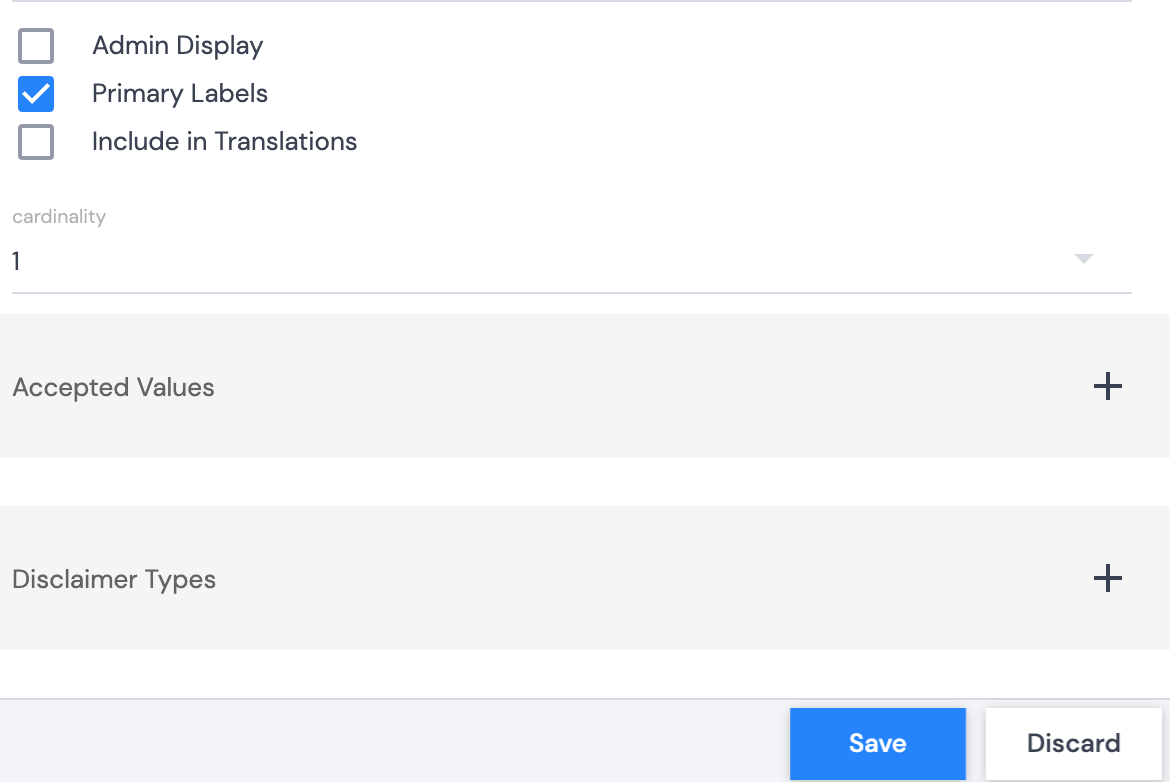
- Admin Display – the property will be visible in Kurtosys under Data or Data Dictionary.
- Primary Label – The property will become a sticky column pinned to the left of the property grid.
- Include in Translations – This will add property values into the Translations module where you can begin to add translations of those terms or phrases at a later stage.
- Cardinality – how many values can this property accept e.g. For the Fund Name property you want only 1 Fund name inserted (cardinality 1), but for Country you can accept more than one value in the field e.g. United Kingdom, Germany and France (cardinality N).
- Accepted Values – Allows you to define the exact values to be inserted into the field. e.g. Country – you can create the finite list of country options the user is allowed to choose from, Luxembourg, United Kingdom, Germany.
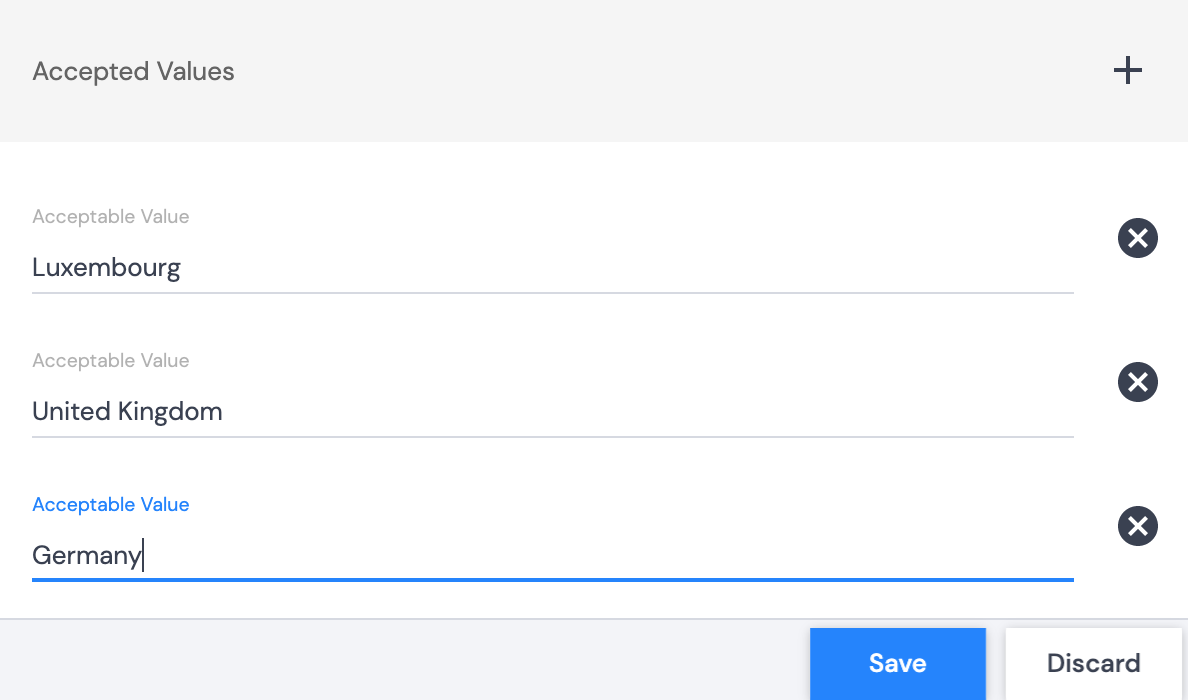
- Disclaimer Types – is not necessary.
Once the form is filled in, click Save and the property will be listed in the Data Dictionary under Properties.
How to set up Allocations Properties in the Data Dictionary
Click + to the right of the Data Dictionary property tabs. This will open a list of property types.
Click Add Allocation Property.
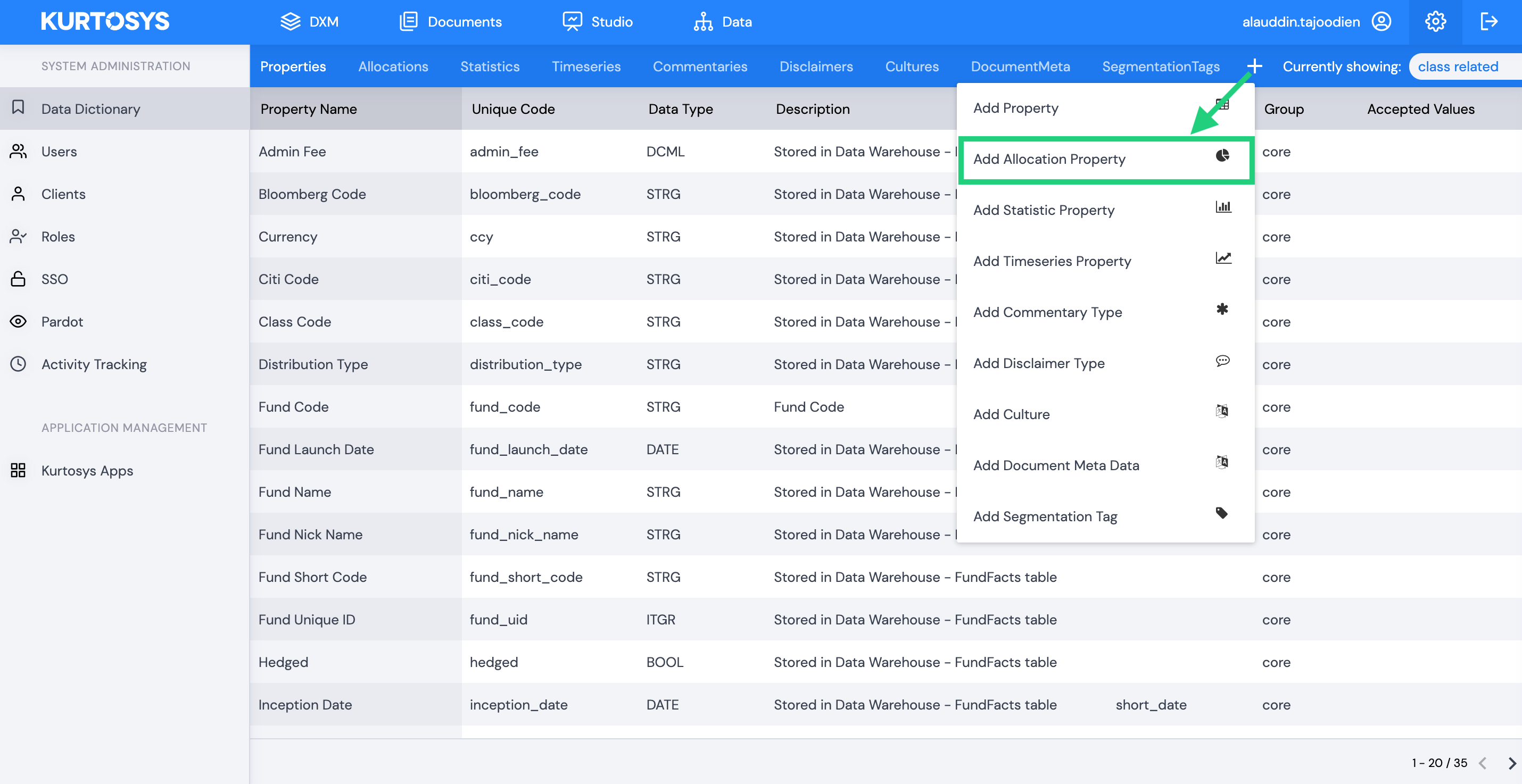
This will open a form.
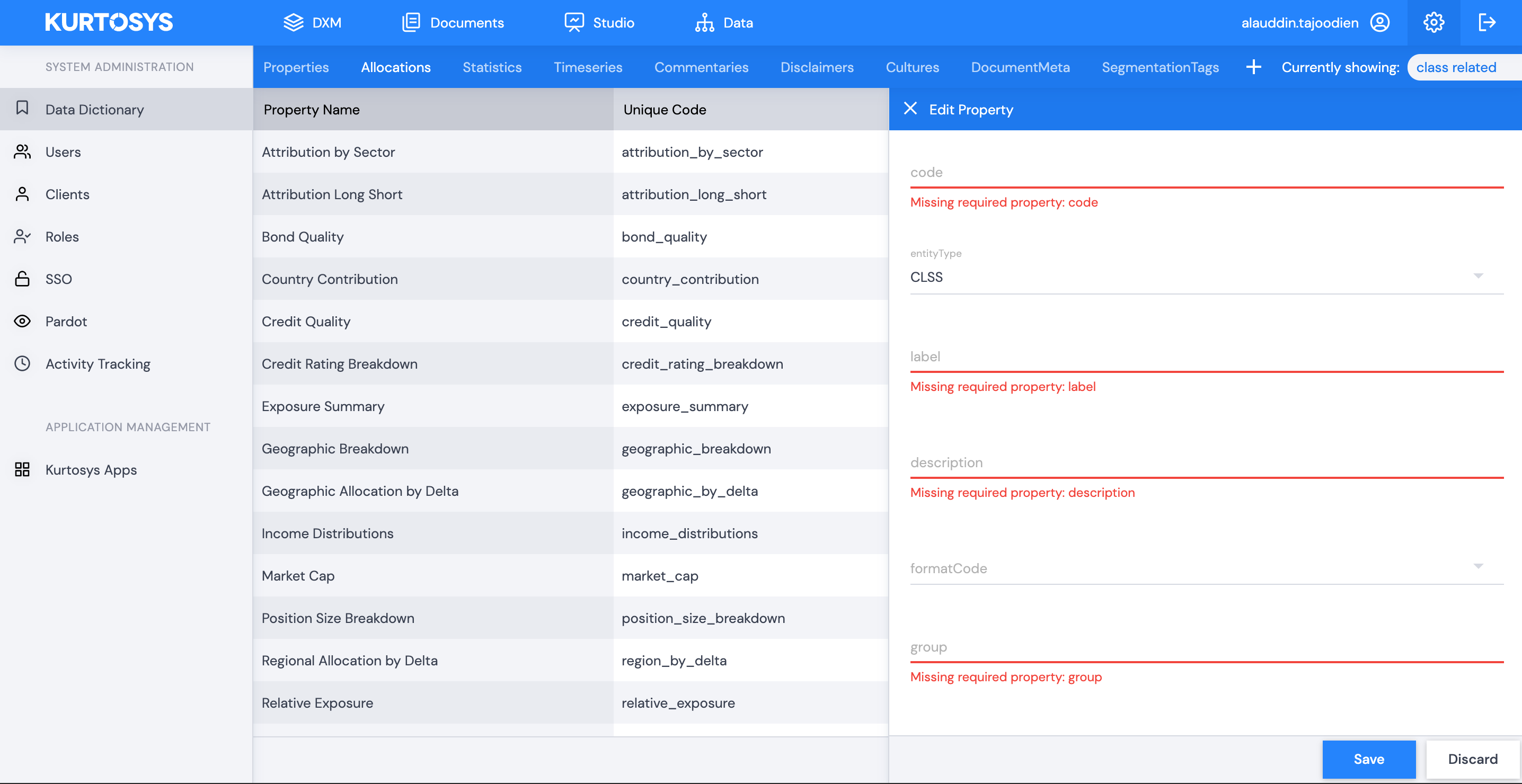
Fill in the form:

- code – this is the system name given to the property so that it is usable as a label in the code. Code should always be written in lower, snake case e.g. property_code_name or property-code-name-example.
- entityType – Kurtosys supports 4 different entity or asset types: FUND (Fund assets), CLSS (Share classes), BMRK (Benchmarks) and ACCT (Accounts). Choose the entity type to which you want to add the property.
- label – the name given to the property that is displayed on the interface.
- description – any additional information about the property and its purpose.
- formatCode – is only applicable when a value needs to be displayed slightly differently to that in dataType e.g. if decimal needs to be presented as a percentage or a date needs to be displayed as a shorter version. The formatCode needs to be defined in the API first, it will then become available as an option under formatCode.
- group – should be set to core.
- subgroup – is not necessary.
- extended – Allows you to use a single allocations property or graph to record multiple data sets for comparison e.g. you want to record the actual allocation, but also monitor the industry benchmark or the net vs gross values.
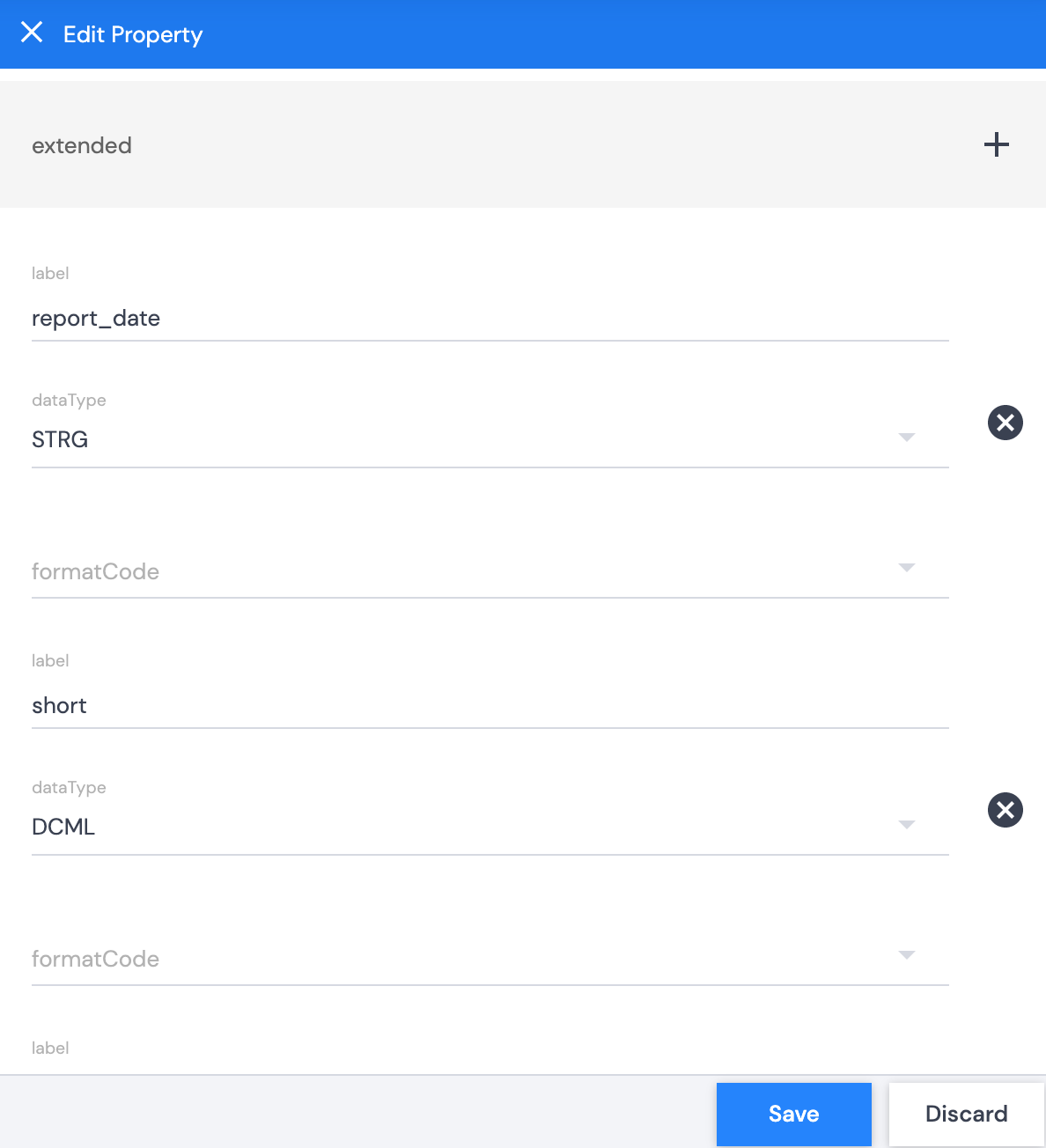
Once the form is filled in, click Save and the property will be listed in the Data Dictionary under Allocations.
How to set up Statistics Properties in the Data Dictionary
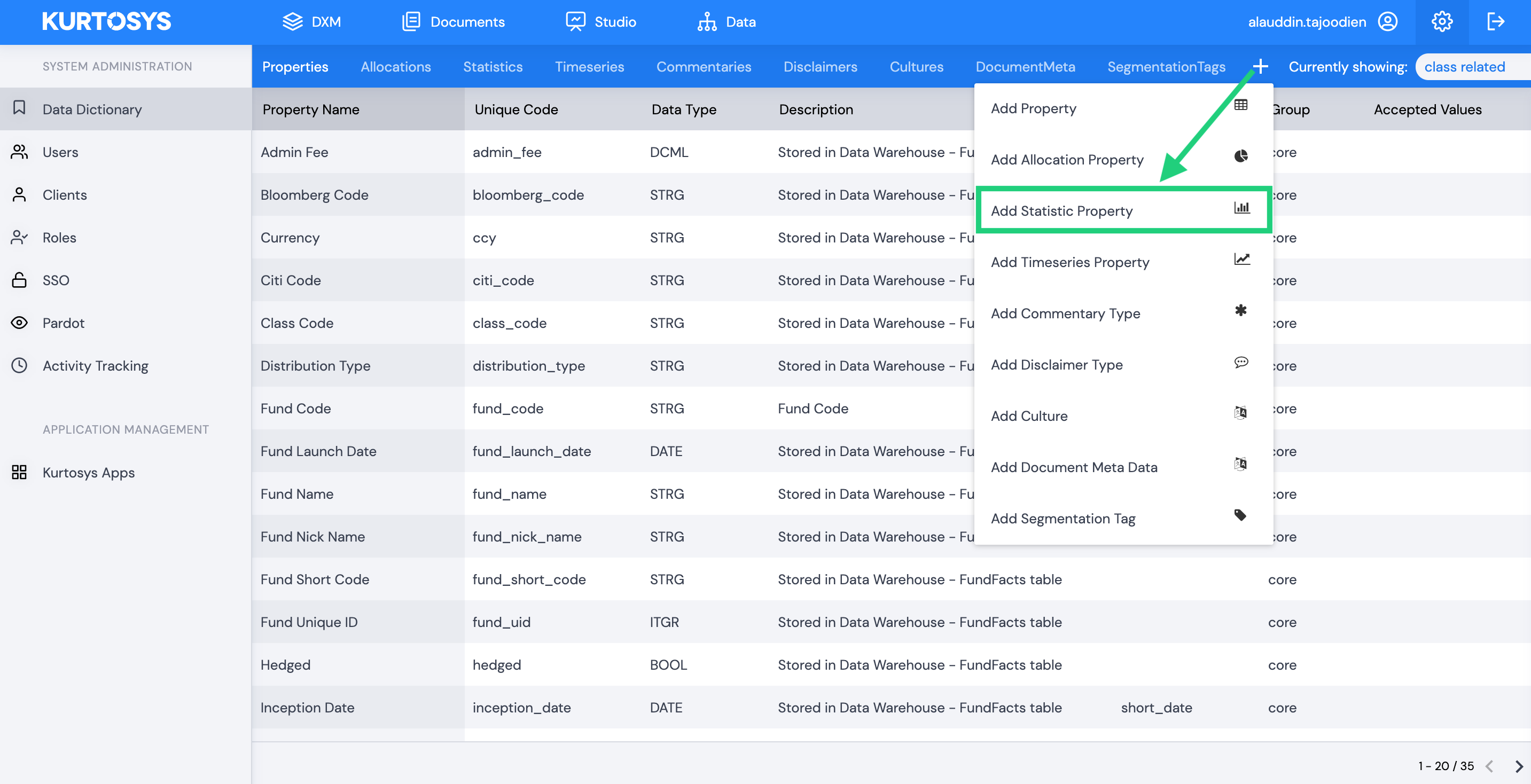
Click + to the right of the Data Dictionary property tabs. This will open a list of property types.
Click Add Statistic Property.
This will open a form.

Fill in the form:
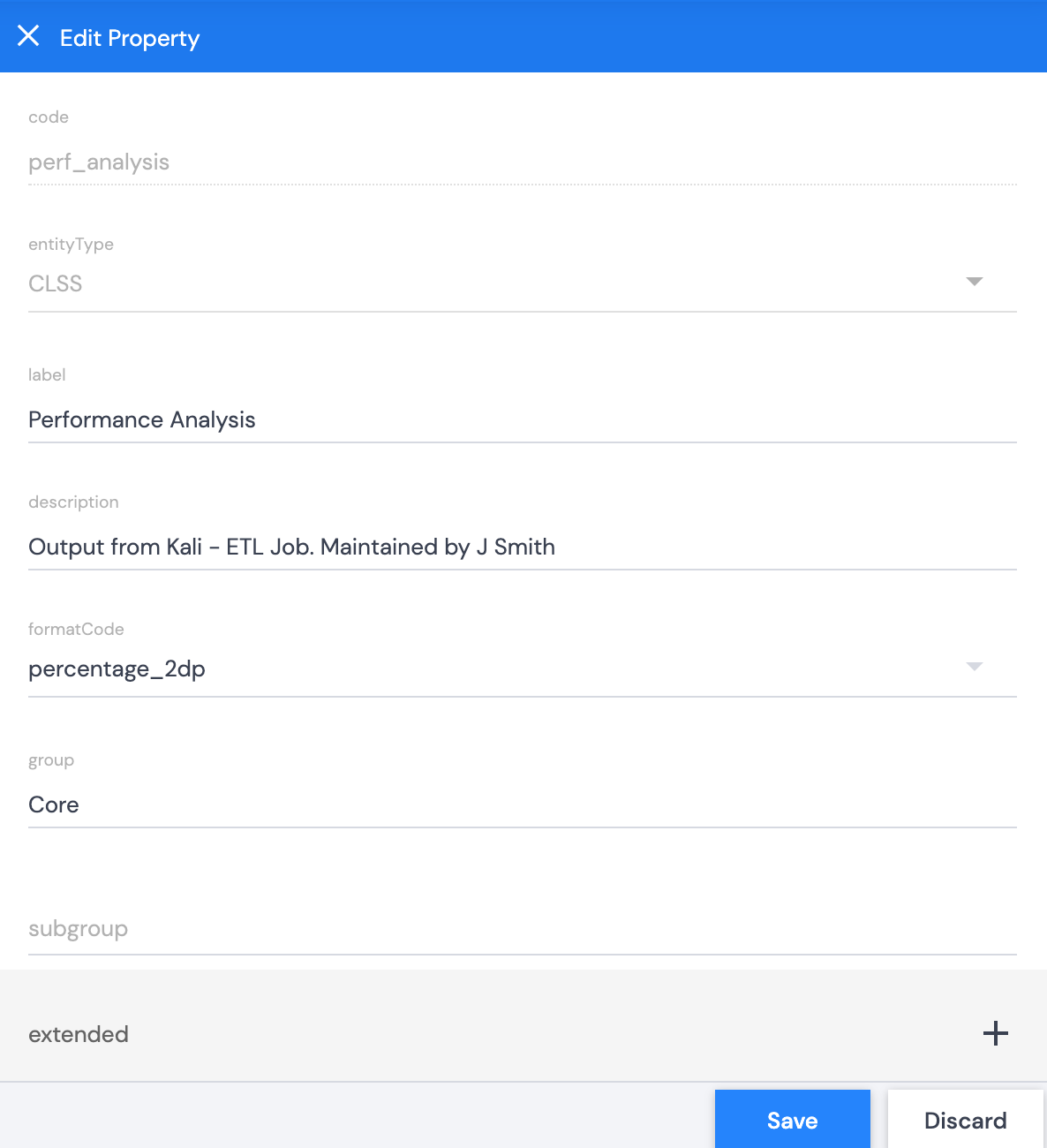
- code – this is the system name given to the property so that it is usable as a label in the code. Code should always be written in lower, snake case e.g. property_code_name or property-code-name-example.
- entityType – Kurtosys supports 4 different entity or asset types, FUND (Fund assets), CLSS (Share classes), BMRK (Benchmarks) and ACCT (Accounts). Choose the entity type to which you want to add the property.
- label – the name given to the property that is displayed on the interface.
- description – any additional information about the property and its purpose.
- formatCode – is only applicable when a value needs to be displayed slightly differently to that in dataType e.g. if decimal needs to be presented as a percentage or a date needs to be displayed as a shorter version. The formatCode needs to be defined in the API first, it will then become available as an option under formatCode.
- group – should be set to ‘core’.
- subgroup – is not necessary.
- extended – Allows you to use a single statistics property to record multiple data sets for comparison e.g. you want to record benchmark returns, relative returns and your actual return values under a single Performance Analysis Property.
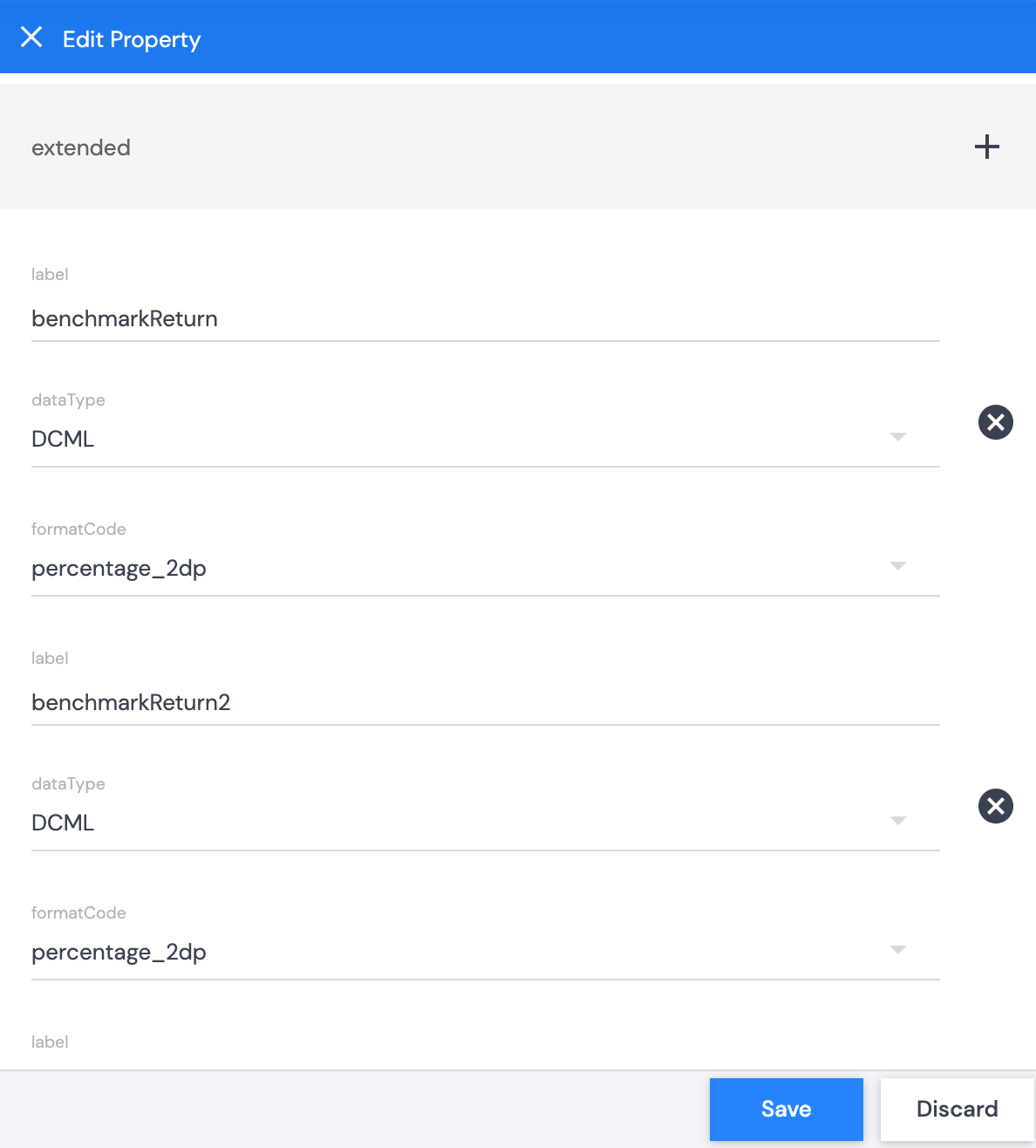
Once the form is filled in, click Save, the property will be listed in the Data Dictionary under Statistics.
How to set up Timeseries Properties in the Data Dictionary
Click + to the right of the Data Dictionary property tabs. This will open a list of property types.
Click Add Timeseries Property.

This will open a form.
Fill in the form:
- code – this is the system name given to the property so that it is usable as a label in the code. Code should always be written in lower, snake case e.g. property_code_name or property-code-name-example.
- label – the name given to the property that is displayed on the interface.
- description – any additional information about the property and its purpose.
- formatCode – is only applicable when a value needs to be displayed slightly differently to that in dataType e.g. if decimal needs to be presented as a percentage or a date needs to be displayed as a shorter version. The formatCode needs to be defined in the API first, it will then become available as an option under formatCode.
- group – should be set to ‘core’.
- subgroup – is not necessary.
- extended – Allows you to use a single timeseries property to record multiple data sets for comparison e.g. you want to record benchmark returns and your actual return values over time under a single Returns Property.
Once the form is filled in, click Save, the property will be listed in the Data Dictionary under Timeseries.
How to set up Commentary types in the Data Dictionary
Click + to the right of the Data Dictionary property tabs. This will open a list of property types.
Click Add Commentary Type.
This will open a form.
Fill in the form:
- commentaryType – the name given to the commentary type that will be referenced under the Commentary Module when creating new commentaries.
- description – any additional information about the commentary type and its purpose.
- Approval Groups – use the type-ahead search to select the group/s of users who will be responsible for checking and approving the commentary before it is ready to publish.
Once the form is filled in, click Save, the property will be listed in the Data Dictionary under Commentaries.
How to set up Disclaimer types in the Data Dictionary
Click + to the right of the Data Dictionary property tabs. This will open a list of property types.
Click Add Disclaimer Type.
This will open a form.
Fill in the form:
- disclaimerType – the name given to the disclaimer type that will be referenced under the Disclaimer Module when creating new disclaimers.
- description – any additional information about the disclaimer type and its purpose.
- Approval Groups – use the type-ahead search to select the group/s of users who will be responsible for checking and approving the disclaimer before it is ready to publish.
Once the form is filled in, click Save, the property will be listed in the Data Dictionary under Disclaimers.
How to set up Cultures in the Data Dictionary
Click + to the right of the Data Dictionary property tabs. This will open a list of property types.
Click Add Culture.
This will open a form.
Fill in the form:
- culture – Using the dropdown menu, choose the culture code you wish to add to Kurtosys.
- isDefault – If selected the chosen culture will become the default language and be used as the key under Translation. The default language cannot be changed and can only be applied to one culture.
Once the form is filled in, click Save, the property will be listed in the Data Dictionary under Cultures.
How to set up DocumentMeta in the Data Dictionary
Click + to the right of the Data Dictionary property tabs. This will open a list of property types.
Click Add Document Meta Data.
This will open a form.
Fill in the form:
- Code – this is the system name given to the property so that it is usable as a label in the code. Code should always be written in lower, snake case e.g. property_code_name or property-code-name-example.
- Label – the name given to the property and is displayed on the interface.
- Description – any additional information about the property and its purpose.
- Validation Rules – should always be set to ‘none’.
- Data Type – what data format can the system expect and therefore how should it be stored and displayed. Data types include STRG (string), DCML (decimal), ITGR (integer), DATE (date format), DTIM (date and time format), BOOL (Boolean – True or False).
- Format Code – is only applicable when a value needs to be displayed slightly differently to that in dataType e.g. if decimal needs to be presented as a percentage or a date needs to be displayed as a shorter version. The formatCode needs to be defined in the API first.
- Cardinality – how many values can this property accept e.g. For the Fund Name property you want only 1 Fund name inserted (cardinality 1), but for Country you can accept more than one value in the field e.g. United Kingdom, Germany and France (cardinality N).
- Accepted Values – Allows you to define the exact values to be inserted into the field. e.g. Country – you can create the finite list of country options the user is allowed to choose from, Luxemburg, United Kingdom, Germany.
- Add Link Meta – automatically adds additional meta data to a document based on the Accepted Value e.g. Given the Accepted Value KIID, I can create Linked Meta Abbreviation – kd. In this way, when you add KIID, the Linked Meta will be automatically added as tags to the document.
- Entity Property Override – For Documents that you want tagged with Fund or Share class meta, you can use the Entity Property Override which will provide the list of values under the Fund or Shareclass property as the Allowed Value list e.g. if you want documents tagged with the ISIN of a Share class then you can choose the ISIN property from the dropdown list. When tagging a document you can now choose an ISIN from the linked list provided.
Once the form is filled in, click Save, the property will be listed in the Data Dictionary under Document Meta.
